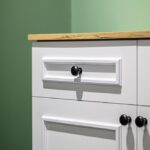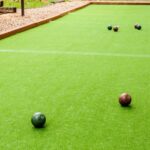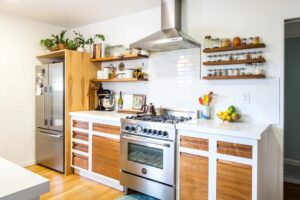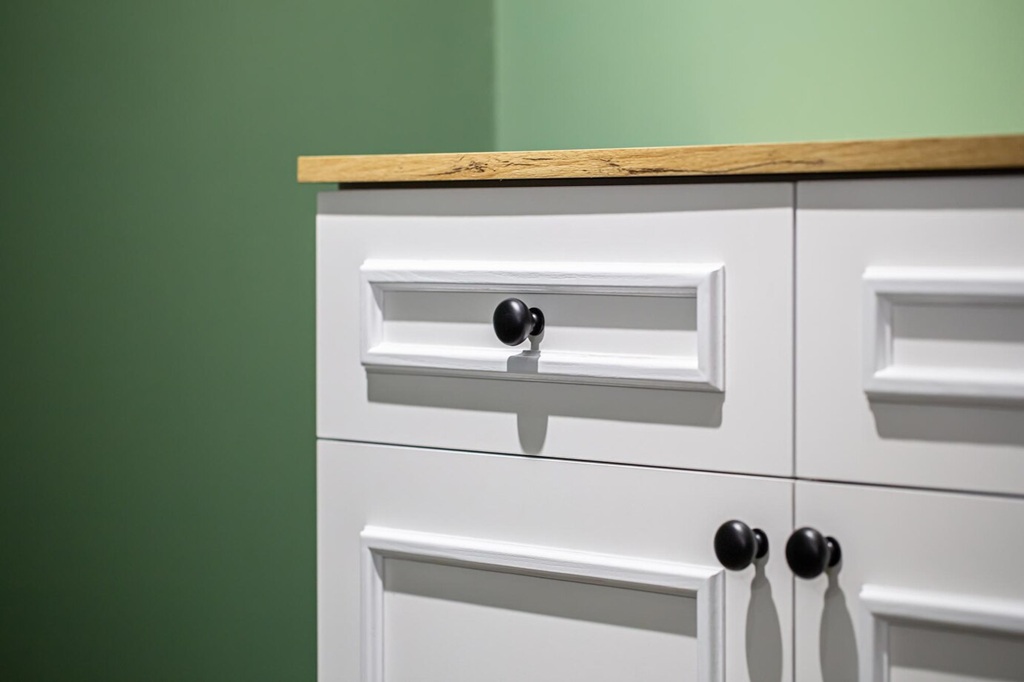
Tired of looking at those dated wood cabinets? You’re not alone! Giving your kitchen or bathroom cabinets a fresh coat of paint is one of the most impactful and budget-friendly ways to completely transform the look and feel of your space. Forget the cost and chaos of a full replacement; the right paint job can make old cabinets look brand new, reflecting your personal style and even boosting your home’s value.
But walking down the paint aisle can feel overwhelming. So many types, finishes, and brands – where do you even begin? Choosing the wrong paint can lead to frustrating results like chipping, peeling, or a finish that just doesn’t hold up to daily life. That’s why picking the best paint for wood cabinets is crucial for a beautiful, long-lasting finish. This guide will walk you through everything you need to know, from understanding paint types to prepping like a pro, ensuring your cabinet makeover is a stunning success.
Why Bother Painting Wood Cabinets?
Before diving into the “how,” let’s talk about the “why.” If you’re on the fence, consider these compelling reasons to give your wood cabinets a colorful facelift:
- Cost-Effectiveness: Painting is significantly cheaper than replacing cabinets entirely. You get a dramatic transformation for a fraction of the price of new cabinetry.
- Style Update: Trends change, and wood finishes that were popular a decade or two ago might feel dated now. Paint offers a modern solution, allowing you to embrace current styles, whether it’s classic white, sophisticated gray, bold navy, or a calming green.
- Increased Home Value: An updated kitchen is a major selling point. Freshly painted cabinets make the space look cleaner, brighter, and more appealing to potential buyers.
- Personalization: Paint lets you infuse your personality into your space. Choose colors that reflect your taste and coordinate perfectly with your countertops, backsplash, and overall home decor.
- Sustainability: Instead of sending perfectly functional cabinets to the landfill, painting gives them a second life. It’s a more environmentally conscious choice.
Decoding Cabinet Paint: Types Explained
Not all paints are created equal, especially when it comes to high-traffic, high-touch surfaces like cabinets. Understanding the main types is key to making the right choice:
Oil-Based (Alkyd) Paints
- The Lowdown: These traditional paints use oil (or synthetic alkyd resins) as a base. They were long considered the gold standard for durability.
- Pros: Known for excellent adhesion, incredible durability, and a hard, smooth, enamel-like finish that levels beautifully, minimizing brush strokes. They are highly resistant to wear, tear, and moisture.
- Cons: They have very strong odors due to high VOCs (Volatile Organic Compounds), requiring excellent ventilation during application and drying. Drying times are significantly longer (often 8+ hours to touch, 24+ hours to recoat, weeks to fully cure). Cleanup requires harsh solvents like mineral spirits or paint thinner. They can also yellow over time, especially lighter colors.
- Best For: High-traffic areas where maximum durability is the absolute top priority, and long drying times/strong odors aren’t prohibitive. Often favored by professionals for specific applications.
Water-Based (Latex/Acrylic) Paints
- The Lowdown: These use water as the main carrier. Modern acrylic formulations have improved drastically over older latex paints.
- Pros: Much lower in VOCs, resulting in less odor. They dry significantly faster (often 1-2 hours to touch, 4-6 hours to recoat). Cleanup is simple with just soap and water. They are more flexible and less prone to cracking or yellowing over time.
- Cons: While much improved, they may not achieve the same rock-hard finish as traditional oil-based paints without specific formulations. Achieving a perfectly smooth, brush-stroke-free finish can sometimes be more challenging. Might require a specific primer for best adhesion and potentially a clear topcoat for maximum durability in very demanding environments.
- Best For: DIY projects due to ease of use, faster drying, and easier cleanup. Good for most cabinet applications, especially when using high-quality acrylic enamel paints designed for trim and cabinets.
Hybrid / Waterborne Alkyd Paints
- The Lowdown: This is where modern paint technology truly shines! These paints aim to combine the best qualities of both oil and water-based types. They use water for cleanup and have lower VOCs but incorporate alkyd resins for enhanced durability and finish quality.
- Pros: Offer the superior hardness, durability, and smooth, self-leveling finish associated with oil-based paints. Provide easier cleanup (soap and water) and lower odor/VOCs like water-based paints. Excellent adhesion and resistance to blocking (sticking).
- Cons: Can be more expensive than standard latex paints. Drying times are typically longer than latex but faster than traditional oil paints. Full cure time (reaching maximum hardness) can still take several weeks, so gentle use is advised initially.
- Best For: Often considered the top choice for painting wood cabinets in 2025. They provide professional-quality results with user-friendly characteristics, ideal for kitchens and bathrooms. Brands like Benjamin Moore Advance and Sherwin-Williams Emerald Urethane Trim Enamel fall into this category.
Finish Matters: Choosing the Right Sheen
The paint’s sheen (or finish) affects not only the look but also the durability and cleanability of your cabinets.
- Matte/Flat: Offers a non-reflective, velvety look that hides imperfections well. However, it’s the least durable and hardest to clean, making it generally unsuitable for kitchen or bathroom cabinets.
- Eggshell: Has a very subtle, low luster – slightly more washable and durable than matte, but still not typically recommended for high-use cabinets.
- Satin: Provides a smooth, pearl-like finish with a soft sheen. It strikes a great balance between aesthetics and practicality – offering good durability and cleanability while being more forgiving of minor imperfections than glossier finishes. A very popular choice for cabinets.
- Semi-Gloss: A popular and practical choice for cabinets, especially in kitchens and bathrooms. It offers excellent durability, is easy to wipe clean, and resists moisture well. The noticeable shine reflects light, brightening the space, but it will highlight surface imperfections more than satin.
- High-Gloss: Delivers a shiny, reflective, almost plastic-like finish. It’s the most durable and easiest to clean. However, it shows every fingerprint, smudge, and surface flaw, requiring meticulous prep work and application for good results. Best suited for ultra-modern styles.
Recommendation: For most wood cabinet projects, Satin or Semi-Gloss finishes offer the best combination of durability, washability, and aesthetic appeal.
Key Considerations for Cabinet Paint Selection
Beyond type and finish, keep these factors in mind:
- Durability: This is paramount for cabinets. Look for paints specifically labeled “Cabinet,” “Trim,” “Enamel,” or “Urethane” as these are formulated for hardness and resistance to wear. Hybrid alkyds generally top the list here.
- Application: Consider how you’ll apply the paint. Some level out better with a brush/roller (foam rollers often give the smoothest finish without spraying), while others are ideal for spraying (HVLP sprayers give the most professional, factory-like finish).
- Drying vs. Curing Time: Don’t confuse “dry to the touch” with “fully cured.” While paint might feel dry in hours, it can take days or even weeks (especially alkyds and hybrids) to reach maximum hardness. Be gentle with newly painted cabinets during the curing period.
- VOCs: If you’re sensitive to smells or concerned about air quality, choose low-VOC or zero-VOC options. Water-based and hybrid paints typically have lower VOCs than oil-based ones.
- Budget: Prices vary. Professional-grade hybrid alkyds tend to be more expensive, but their performance often justifies the cost for a long-lasting cabinet finish. High-quality latex enamels can be a good mid-range option.
Related: Living Room Colour Chemistry: The Perfect Paint Combinations for All Styles
Top Contenders: Best Paints for Wood Cabinets in 2025
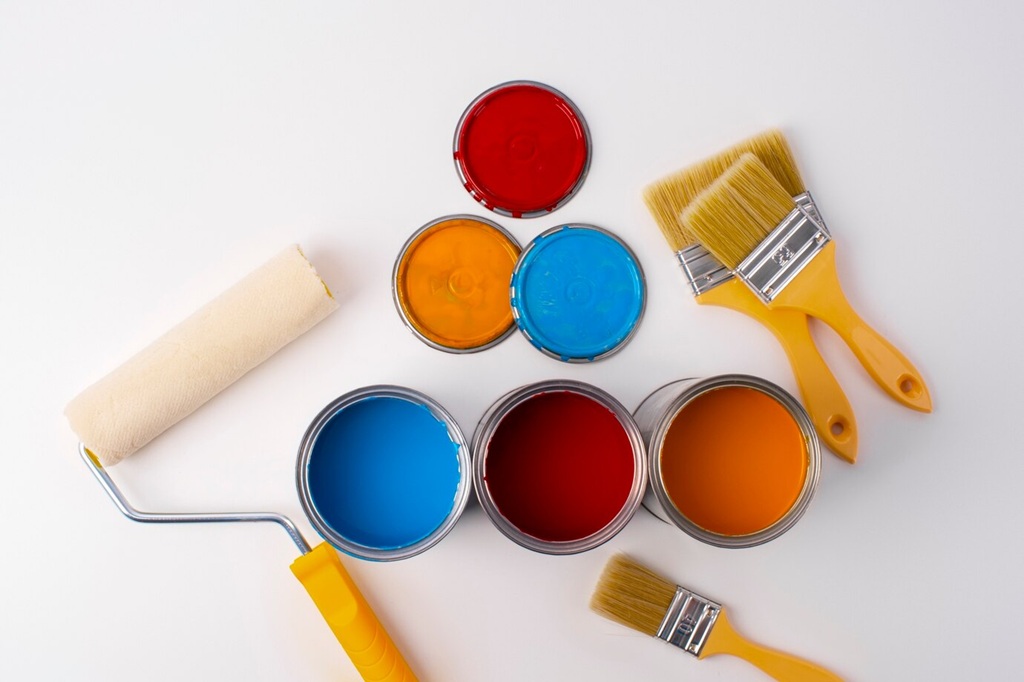
Based on professional recommendations, testing, and user reviews, here are some top-performing paints frequently cited for wood cabinets as of early 2025:
- Benjamin Moore ADVANCE (Waterborne Alkyd): Often hailed as the overall best. Known for its exceptional self-leveling properties (minimizing brush marks), durable finish comparable to oil, easy water cleanup, and wide color availability. Requires patience during its longer cure time.
- Sherwin-Williams Emerald Urethane Trim Enamel (Waterborne Alkyd): Another top-tier choice. Offers excellent durability, flow, and leveling for a smooth, hard finish resistant to chipping, fading, and yellowing. Great for high-traffic areas.
- Behr Premium Cabinet & Trim Enamel (Water-Based Alkyd/Urethane): A highly-rated option often praised for its value. Provides good coverage, a hard, durable finish, and relatively fast drying time for its category. Available in Satin and Semi-Gloss.
- INSL-X Cabinet Coat (Waterborne Acrylic): Specifically designed for cabinets, this paint offers excellent adhesion (even to tricky surfaces), great coverage, and a hard, factory-like finish. Often requires minimal prep compared to others.
- Dixie Belle SILK All-In-One Mineral Paint: A unique option gaining popularity, especially in the furniture/cabinet refinishing community. Features a built-in primer and topcoat, low VOCs, good flow, and a smooth finish.
- Wise Owl One Hour Enamel: Known for its incredibly fast cure time (claiming hardness in just one hour), making it unique. Offers good durability and self-leveling properties.
Note: Always check the specific product details and application instructions, as formulations can change.
The Secret to Success: Proper Preparation
You can buy the most expensive paint, but if you skip the prep work, your results will be disappointing. Prep is non-negotiable for a professional, lasting finish.
- Remove Hardware & Doors: Take off all knobs, pulls, and hinges. Remove cabinet doors and drawer fronts. Label everything clearly so you know where it goes back!
- Clean Thoroughly: This is critical. Kitchen cabinets accumulate grease, grime, and cooking oils. Use a good degreaser (like TSP substitute or Krud Kutter) and scrub all surfaces well. Rinse and let dry completely.
- Scuff Sand: You don’t need to sand down to bare wood, but you do need to lightly sand (scuff) all surfaces to remove the existing sheen and create microscopic grooves for the primer to grip. Use 120-180 grit sandpaper. Focus on smoothing any rough spots.
- Wipe Down Dust: After sanding, remove all sanding dust with a vacuum, followed by a tack cloth or a slightly damp microfiber cloth. Dust is the enemy of a smooth finish.
- Prime Time: Priming is essential for adhesion, blocking stains (especially from wood tannins like oak), ensuring even color coverage, and creating a uniform surface for the paint. Use a high-quality bonding primer. For wood prone to bleeding (like oak or mahogany) or covering dark stain, a stain-blocking primer (shellac-based like BIN or oil-based) might be necessary, followed by a bonding primer or directly by paint if compatible. Products like Zinsser BIN Shellac-Based Primer or INSL-X Stix Waterborne Bonding Primer are often recommended. Apply primer evenly and let it dry completely per manufacturer instructions.
Related: 10 Ideas of orange paint colors for living room
Achieving a Flawless Finish: Application Tips
With prep done, it’s time for the fun part!
- Use Quality Tools: Invest in good brushes (angled sash brush for details), mini foam rollers (for smooth flat areas), or consider renting/buying an HVLP sprayer for the ultimate finish.
- Thin Coats are Key: Apply thin, even coats rather than one thick coat. This prevents drips, ensures proper drying, and results in a harder finish. Two or even three thin coats are standard.
- Brush then Roll: When using both, brush detailed areas/corners first, then immediately go over flat areas with the roller to smooth out brush marks. Work in manageable sections.
- Sand Between Coats (Optional but Recommended): Once the primer or a paint coat is fully dry, lightly sand with fine-grit sandpaper (220-grit or higher) and wipe clean. This removes minor imperfections and ensures maximum adhesion for the next coat, leading to a smoother final finish.
- Follow Drying Times: Respect the recommended drying times between coats listed on the paint can. Rushing this step can ruin the finish.
- Allow for Curing: Remember the difference between dry time and cure time. Avoid heavy use, aggressive cleaning, or replacing hardware too soon. Give the paint time (days to weeks) to fully harden.
People Also Ask: Your Cabinet Painting FAQs Answered
What type of paint is best for wood cabinets?
Hybrid waterborne alkyd paints (like Benjamin Moore Advance or Sherwin-Williams Emerald Urethane) are often considered the best overall choice currently. They offer the durability and smooth finish of oil-based paints with the easier cleanup and lower VOCs of water-based options. High-quality acrylic enamels specifically for cabinets are also a good choice.
Do I really need to sand cabinets before painting?
Yes, absolutely. Scuff sanding is crucial. It removes the gloss from the old finish and creates a slightly rough surface (a “tooth”) that the primer and paint can securely bond to. Skipping this step is a primary cause of paint peeling or chipping later.
What is the most durable paint finish for cabinets?
Technically, high-gloss is the most durable and easiest to clean. However, it shows imperfections readily. Semi-gloss offers excellent durability and cleanability and is a very popular choice for kitchens and baths. Satin is also a durable option that hides flaws slightly better than semi-gloss.
Should I use oil-based or water-based paint for cabinets?
For most DIYers, modern water-based acrylic enamels or waterborne alkyds (hybrids) are recommended. They offer great durability with easier application, faster drying, lower odor, and soap-and-water cleanup. Traditional oil-based paint offers maximum durability but comes with strong fumes, long drying/curing times, and difficult cleanup.
Do I need to prime wood cabinets before painting?
Yes, priming is highly recommended, if not essential. A good bonding primer ensures the paint adheres properly, prevents stains or wood tannins from bleeding through (especially on oak), and provides a uniform base for even color. Use a quality bonding and/or stain-blocking primer.
How long does cabinet paint take to cure?
This varies greatly by paint type. Latex/acrylic paints might cure significantly in a few days to a week. Oil-based and hybrid alkyd paints can take much longer – often 2-4 weeks or even longer to reach maximum hardness and durability, even if they feel dry to the touch much sooner. Check the manufacturer’s specifications and be gentle during the curing period.
Can you paint laminate end panels on cabinets?
Yes, you often can, but proper prep is critical. Clean the laminate thoroughly and use an excellent bonding primer designed for slick surfaces (like Zinsser BIN or Stix). Lightly scuff sanding the laminate first can also improve adhesion.
Is painting cabinets a good DIY project?
It can be, but it requires patience and attention to detail, especially during the prep phase. If you rush the cleaning, sanding, or priming, the results may not last. For a guaranteed professional finish, hiring experienced cabinet painters is a worthwhile investment.
Related: What You Should Know Before Replacing Your Kitchen Cupboard Doors
Conclusion
Painting your wood cabinets is a fantastic way to breathe new life into your kitchen or bathroom without the expense of a full renovation. The key to success lies in diligent preparation and choosing the right products for the job. Prioritize durability by selecting a high-quality paint specifically designed for cabinets and trim – modern waterborne alkyds often provide the best balance of performance and user-friendliness. Opt for a satin or semi-gloss finish for a blend of good looks, cleanability, and toughness.
Don’t skimp on cleaning, sanding, and priming; these steps are the foundation for a paint job that will look great and withstand the rigors of daily use for years to come. While it takes time and effort, transforming your cabinets with the perfect paint is an incredibly rewarding project that will make you fall in love with your space all over again. Happy painting!

